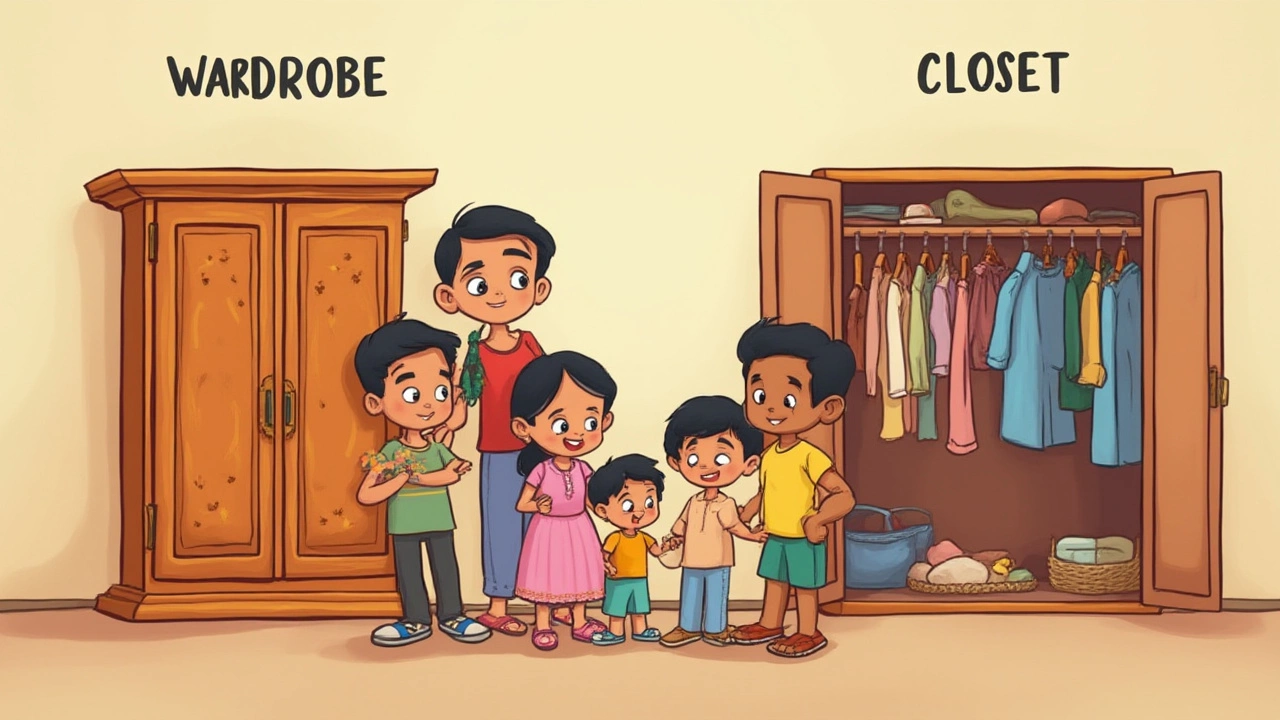You overhear Americans talking about their new "closet organizer" and suddenly realize—wait, do they even say wardrobe? It’s one of those subtle things that trip up anyone watching US TV or planning to buy furniture stateside. Dig into English, and you suddenly notice words for everyday stuff—like where you hang your shirts—can be wildly different depending on where you are.
Defining Wardrobe: One Word, Many Meanings
So what exactly is a wardrobe in the first place? Traditionally, a wardrobe is a standing cabinet where you store clothes. You open it, hang up your shirts on a rod, maybe stash folded jeans on a shelf, and tuck shoes below. They’re big, sometimes ornate, and can even be vintage or modern sleek. If you grew up in Australia, the UK, India, or much of Europe—wardrobe is the go-to term. The story shifts in the US. Americans rarely use the word "wardrobe" for a piece of furniture. Instead, when they mention wardrobe, they often mean an entire clothing collection, like “her summer wardrobe,” or even a costume department on a movie set.
When talking about the actual furniture, Americans call it something else. The commonest term is “closet” for a built-in storage space, and sometimes “armoire” for a large, freestanding cabinet, especially if it’s decorative. The Oxford English Dictionary tracks "wardrobe" back to Old French "garderobe," meaning a place to keep one's robes—literally, your personal clothing protector. While Brits held onto the word for daily use, Americans found "closet" worked better for their changing houses.
Here’s the translation puzzle: if you’re browsing homes in New York, you’ll seldom see a listing mention a wardrobe. Instead, everyone wants “ample closet space.” In apartments, closets are recessed storage spaces with doors, built right into the wall—think of that tiny room Harry Potter gets shoved into in the first film. If someone needs free-standing storage, they might call it an “armoire” or “wardrobe,” but these words sound posh or old-fashioned to a lot of people over there. In furniture stores, “wardrobe” sometimes pops up for tall, standalone cabinets, but “closet” is the king of American bedrooms.
Why Do Americans Say Closet Instead?
The switch from “wardrobe” to “closet” is tangled in history and architecture. Early American houses grew big, with more rooms and more space to hide things. In colonial days, you’d have a big wooden wardrobe if you were rich, since most normal homes were too small for such large furniture. But as American homes got roomier, builders started carving out entire storage spaces—closets—right into the blueprints. In the US, closets are practically a baseline requirement for every proper bedroom, not just a nice add-on. This habit stuck and spread.
The word “closet” actually used to mean a small private room for study or prayer—imagine the old phrase “skeletons in the closet” for family secrets. Somewhere in the 19th and early 20th centuries, “closet” shifted in American usage to mean a small room (or big cupboard) to store clothes, shoes, and boxes of stuff you forgot you owned. Suddenly, having “a walk-in closet” was a dream for house-hunters. In Britain and Australia though, closets might mean little broom cupboards, and most bedrooms still rely on stand-alone wardrobes for personal storage.
Check out TV shows for a fun real-world example. US sitcoms—Friends, Modern Family, even movies like Clueless—constantly talk about closets, not wardrobes. Rachel spends hours reorganizing her closet; Cher’s iconic digital outfit selector lives in a walk-in closet, not a wardrobe. Meanwhile, if you watch Downton Abbey or a British soap, people open their wardrobes—and almost never say “closet.” Words reflect the homes people actually live in. If American architects had stuck with small brick houses, maybe wardrobe would have survived. But America built bigger, and closets took over.
It doesn't stop at closets and wardrobes, either. The US-English vs UK-English furniture divide runs deep—sofas vs. couches, taps vs. faucets, rubbish bins vs. garbage cans. Knowing these language quirks helps anyone searching for furniture online, especially secondhand. You’ll save hours by using the word “closet” on an American site, “wardrobe” in the UK, and “robe” sometimes in Australia. Swapping the terms can be just as confusing as asking for chips at a diner and being handed a bag of crisps!

Shopping and Decorating: Navigating US Furniture Lingo
Let’s say you’re moving to the States, or just trying to order the right furniture from an American site—will you find a “wardrobe” in the catalogue? Maybe, but you’re more likely to find one by searching for “armoire” or “freestanding closet.” Modern home stores like Ikea, Wayfair, and Home Depot often use “wardrobe” for specific large cabinets with rods for hanging clothes—the Pax wardrobe from Ikea is a classic. But outside big chains, most Americans use “closet system,” “closet organizer,” or just “closet.”
Sometimes, “wardrobe” in the US refers to a garment rack or a portable closet—a zip-up fabric cover over a cheap metal frame, often for college dorms or temporary rentals. If you want a sturdy, ornate wooden piece, “armoire” is more accurate. “Armoire” comes from French, just like “wardrobe” originally did, and in the US it signals a fancier, free-standing unit—maybe antique, maybe fitted for a TV back in the 1990s.
Need some translation tips when buying or talking about clothes storage in different countries? Here’s a cheat sheet:
- In America: Say “closet” for anything built-in, “wardrobe” or “armoire” for large stand-alone furniture
- In Britain: Say “wardrobe” for both built-in and free-standing, “closet” is rare
- In Australia: You’ll hear “wardrobe” or sometimes just “robe,” but rare to hear “closet” for furniture
- On US furniture sites: Use search terms like “closet organizer,” “wardrobe closet,” or “armoire”
- At thrift shops or antiques fairs: In America, an “armoire” likely means the same thing as a wardrobe in the UK
And if you’re measuring up for your own clothes storage, think in inches and feet, not centimeters—US measurements are almost always imperial for closets and wardrobes. A so-called “reach-in closet” (classic small American bedroom style) is usually about 6 feet wide and 2 feet deep. “Walk-ins” can start at about 4 feet by 6 feet and only get larger.
Here’s a quick look at how many average US homes have built-in closets, compared to wardrobes elsewhere:
| Country | % of Bedrooms With Built-In Closets | Most Common Term |
|---|---|---|
| United States | Over 90% | Closet |
| United Kingdom | Less than 40% | Wardrobe |
| Australia | About 65% | Wardrobe / Robe |
| Germany | About 20% | Schrank / Wardrobe |
These stats help if you’re relocating, or just obsessed with home design. Knowing the local lingo gives you the right terms for Google searches, furniture orders, or chatting to the real estate agent. (You don’t want to turn up to an American apartment, proudly told there’s “tons of closet space,” and wonder where the freestanding wardrobes have gone!)
Unpacking Language: Fun Facts, Trivia, and Language Tips
The US-English and UK-English furniture divide is loaded with fun details. Did you know that IKEA, the world’s biggest furniture retailer, changes its product language depending on country? A “PAX wardrobe” in Sydney is an “armoire” or “wardrobe system” in Chicago, but in London, it’s just “wardrobe.” Americans shopping on UK websites might miss great secondhand deals just because they’re searching with the wrong keywords. The same deal happens the other way around. Fancy watching another true oddity? In old US houses, a “linen closet” isn’t for clothes at all, but for towels and bedding, tucked into the hallway.
Wardrobe also pops up in all sorts of figurative American uses—“spring wardrobe refresh,” “award season wardrobes,” “she updated her wardrobe for the new job.” Americans do use “wardrobe” for personal clothing collections, costumes, and fashion talk; just not for everyday furniture. The old mix-up between “closet” and “wardrobe” kicked off a wave of English language web searches—right now, Google Trends shows “wardrobe vs closet” as a perennial phrase, with spikes every season as people shop and move house. Americans Google “how to organize closet” about three times more often than “how to organize wardrobe.”
Some other fun trivia:
- The Narnia wardrobe from C.S. Lewis’ books would probably be called an “armoire” in the States.
- In classic American films, “wardrobe” usually means the costume department—the team picking out actors’ outfits.
- “Coming out of the closet,” for LGBTQ+ discussions, only works in American English—“coming out of the wardrobe” would confuse most Americans!
- In parts of Canada, both “closet” and “wardrobe” are common. Ontario homes mix and match, sometimes using “cupboard” for storage spaces.
- Americans still have “wardrobe malfunctions”—nobody ever frets about a “closet malfunction.”
When you visit American friends, saying “Where’s your wardrobe?” will get funny looks. (And if you watch “The Lion, the Witch and the Wardrobe” on US TV, that’s probably the one moment Americans do accept the term without question.) It’s one of those odd places where two cultures, speaking the same language, imagine the inside of a bedroom completely differently—a room with a built-in space you step into, or a beautiful old piece against the wall.
Knowing these differences is a small, useful superpower. Whether you’re shopping, planning a house move, or just trying to follow a TikTok home décor trend, the right word makes all the difference. Americans say “closet”—and now you know why.

